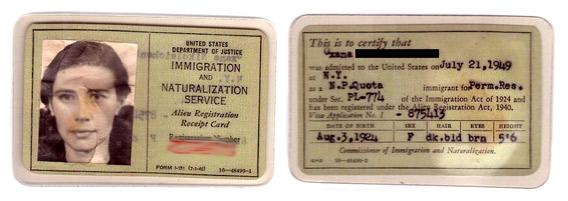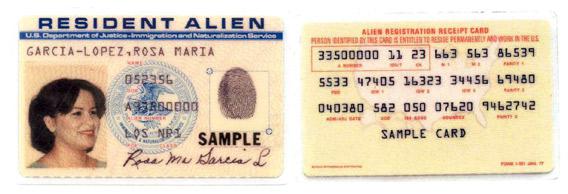As Fourth of July rolls around, and we predictably reflect on all things American, I reflected about the one thing that makes me (officially, sort of) American: my green card. I look at it, and it’s hard not to wonder, why isn’t my green card green? This card that has allowed me to work, go to college, get federal aid, and travel abroad freely since 2007, is in fact beige. This year, I decided that I would find out the answer.

Green card issued in 2007.
Courtesy of the author.
The answer has to do primarily with fraud, explains Marian Smith, historian at the United States Citizenship and Immigration Services, or USCIS. Although the permanent resident card became green again in 2010, understanding the changes it has gone through requires looking back at the original green card.
The United States hasn’t always attempted to obsessively control immigration. It was only in 1940 that the Alien Registration Act required, for the first time, that all non-U.S. citizens register with the federal government at post offices. Their registrations were forwarded to Immigration and Naturalization Services, which then mailed noncitizens Alien Registration Receipt cards.
The first “green card” appeared after World War II, when the Internal Security Act of 1950 required all immigrants with Alien Registration cards, or AR-3, to replace them with the new, green “Form I-151.” Then, perhaps because Alien Registration Receipt Card was too long, everyone started calling it green card.

Immigration and Naturalization Service via Wikimedia Commons.
In the outset of WWII, as babies were booming and Rosies were Riveting, the United States became more attractive to immigrants, and counterfeit green cards became a serious problem. To fight document fraud, INS redesigned the green card 17 times between 1952 and 1977, according to the American Immigration Lawyers Association. In 1964, for example, it changed to pale blue. These color changes helped immigration officials more quickly identify new and expired versions. In 1977, the INS switched to centralized card production at the Immigration Card Facility in Texas, where the green cards—formerly flimsy pieces of paper—became more like driver licenses or credit cards, durable IDs that could be scanned by a machine. In addition to preventing the disintegration of a green card in the wash, this also made it easier for officials to access file data.

January 1977 green card design.
Courtesy of Messing Law offices.
Though over the past five years immigration to the United States has slowed down, and in the case of Mexico, has actually begun reversing, green card fraud is as big as a concern as ever, says Bill Wright, spokesman at the Office of Communications at USCIS. In May of 2010 the green card once again embraced its namesake color. The new version is “pretty darn impossible to reproduce illegally or fraudulently,” Wright says. This has little to do with the color, however. Rather, its new high-tech features, like miniaturized faces of presidents, holograms, and color-shifting ink, he says, are what make it extremely challenging to replicate.

USCIS.
Newer green cards, like mine, expire after 10 years, but a resident is eligible to apply for citizenship after five years. During the naturalization process, immigration officials take your green card, so if all goes well I will be turning in my beige card for a blue passport soon.